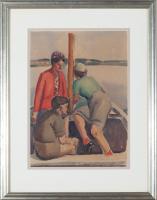Estimate: $18,000/$25,000
Dorrit Black received her initial training at the South Australian School
of Arts and Crafts, later continuing her studies with Julian Ashton in
Sydney. In 1927, she travelled to London, where she studied under Claude
Flight at the Grosvenor School of Modern Art, before moving to Paris to
work with André Lhote. While Lhote profoundly influenced her understanding
of design, it was Flight who shaped her technical approach to printmaking.
Drawing from both mentors, Black forged a bold and distinctive visual
language that was ground breaking in Australia during the late 1920s.
...
In a 1929 article for the Adelaide Observer, Black explained her commitment
to the principles of modernism:
“Modern art does not aim at realism; it is founded on design, harmony,
and rhythm in forms. There is more abstraction than realism in it.”
Upon returning to Australia, she founded the Modern Art Centre in Sydney in
1931—the first gallery in the country established and run by a woman.
Though modest in scale, the Centre became a vital hub for modernist ideas,
showcasing experimental work and offering classes that introduced
Australian audiences to the radical aesthetics of European modernism.
In 1939, Black returned to Adelaide, where she designed and built her own
home and studio in the suburb of Magill. She remained an influential
presence in the local art scene, teaching part time at the South Australian
School of Art and serving as vice-chairman of the Contemporary Art Society.
She continued to exhibit regularly until her sudden death in a car accident
in 1951.
Dorrit Black’s work is held in major public collections, including all
state galleries, the National Gallery of Australia, and the Victoria &
Albert Museum London. In 1975, her contribution to Australian art was
recognised with a major retrospective at the Art Gallery of South
Australia.
Read more


